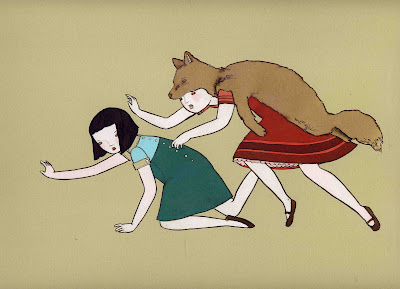
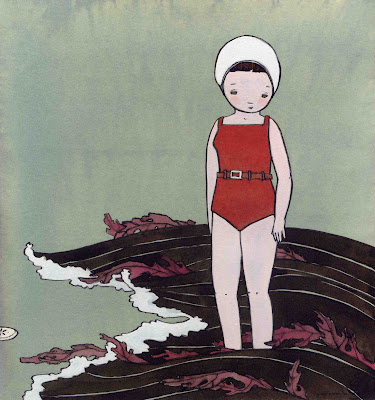
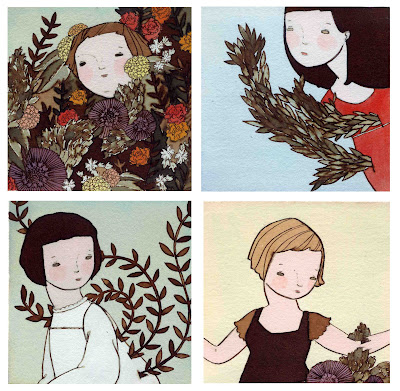

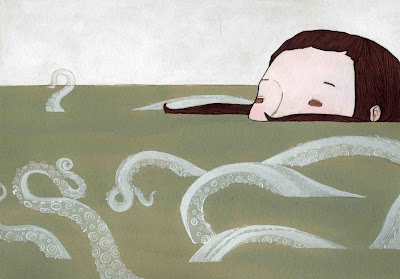
Jen Corace
* Location: Providence, Rhode Island USA
* How would you describe your art?: I have the worse time describing my art, so I will try to keep it brief...The best I can say is that I am interested in the atmosphere of a moment. I draw figures...mostly women or girls...caught up in a scene where something is just about to happen or an event has already passed. I enjoy the tension that is created in not allowing the viewer to know what happens next.
* Currently working on: My second children's book with Chronicle Books and a solo show in the fall.
* 3 Dislikes: Litter bugs, smoking, wet paper (sopping wet paper)
* 3 Likes: Walking, time to myself, the ocean.
* Daily Inspirations: The shore, time spent out on my roof staring and looking, my friends
* People & artists you admire: My brother, my friends, Joseph Cornell, Carson Ellis, Apak, Jo Dery, C.W. Roelle, Evah Fan, Justin B. Williams, Jeana Sohn, Keith Shore, Amy Bennett, Amy Ross, and on and on and on...
* Favourite album(s) to listen to when working: When I am drawing or figuring out compositions: Sodastream, Bonnie "prince" Billy, Blonde Redhead, Destroyer, Yo la Tengo... When I am inking and painting: The Wedding Present, Deerhoof, more Destroyer, Of Montreal, The Kinks
http://www.jencorace.com/
- - -
This interview took place at the beginning of April 2007. Many thanks to Jen for allowing me to reproduce examples of her artwork here.
This interview took place at the beginning of April 2007. Many thanks to Jen for allowing me to reproduce examples of her artwork here.
- - -
Hi Jen, how are you?
Right now I am doing great. I was really sick for three weeks, I couldn't shake it at all. It cleared up at the end of last week and then I went on a three day juice fast with my house mates and I feel better than ever.
How did you first get started in art, is it something that you’ve always been interested in and excelled at?
I grew up always drawing, always painting. I spent a lot of time in my room, by myself, door closed with pads and pads of paper. It's hard to say if a kindergartner or an elementary aged child "excels" at art. It was just something I always loved to do.
I read somewhere that you received a lot of parental encouragement over your artwork as a child.
I am really interested in what makes people be creative and put their ideas and work out into the world when so much is telling us not to, or that our ideas are not ‘good enough’.
Do you think that parental encouragement was instrumental in your belief in yourself, and in your work today?
The encouragement that I received from my mom in my early development definitively put me on the road to where I am now. She always enrolled me in after school and summer art programs and when the time came, researched art schools with me. So she created this momentum that supported the idea that art was where I belonged.
My mom passed away after my sophomore year of RISD. Her death turned my life and who I thought I was on its ear. But in the years that followed, in the re-evaluation and redefining of my life figured out how I wanted to work. I wanted my work to reflect who I was, to be personal. I didn't want to be defined simply by a catchy style or have to develop a style through dry, commercial jobs.
What is your current relationship to your confidence in your artwork?
Confidence is a funny thing. It ebbs and flows. I have a brain like anyone else and it gives me shit all the time. What it ultimately boils down to is that my art is where I get to work my insides out. It's me, my voice and who is going to do me better than me? Nobody.
I read somewhere that you have your own silk-screen studio, and have also moved from heavy acrylic paint work to more use of watercolours.
Which artistic techniques do you employ most often within your work, and enjoy using?
These days I am strictly a watercolour, pen and ink and spare use of acrylic type of girl. I am delving more and more into pattern and hand cramping foliage work.
There is a particular “look” to your work, a specific “feel” or “mood” that pretty much allows me to spot, or feel a piece of your work from ten paces! It appears that a lot of your work is consistently atmospherically based.
To what degree does the colour palette you use, or the scenes/scenarios that you create direct or dictate the atmosphere you require to portray a particular mood?
I don't think that one could work without the other, though I think that colour has a stronger hand. In various series that I have done, when the palette has been set into motion, I sometimes take a piece or two and alter the hues a bit. And just the smallest amount of tweaking can make or break an image within that series.
Thinking about mood and atmosphere, your own personal experiences must influence what you create. Do you find it difficult to create and paint when in particular moods due to how it may influence the ‘feel’ of a piece?
The images themselves pop up in certain moods. And so long as I can write it down or sketch it out in the moment I can generally get a honed drawing done at another time. It also helps that I have particular music that I listen to when I am just drawing. They are the sort of albums that occupy the right parts of the brain.
There’s something abut your work that appeals very much to the side of me that struggles with depression. Not to say that your work is in any way depressing, far from it, but it appears to me that there are undercurrents of sweet sadness within your work that tap into, or almost manage to nip under any smokescreen of happiness. Your paintings in that sense almost seem to know too much.
Whether it be snakes under foot, or a head turned away - hidden from shot, or a black sea current nipping at somebody’s ankles, an encroaching fog, or a ‘tub monster’, there’s always the darker side just there on the sidelines. But yet it’s there in a way that is tolerable, not yet scary or out-of-control; however you know it has the potential to possibly rear its head.
This is my personal attraction to and identification with your work, though I realise it is completely subjective! You have however referred to how in creating your art it allows you to secure personal space and articulate your perceptions of loneliness, solitude, or reflection.
How easy is it to depict, or comment on darker themes of loss, solitude, loneliness, or nostalgia with a sense of subtlety, or sweetness?, thus potentially allowing your work to work on different levels of ‘mood’, or appeal to different audiences/age ranges?
Is it ever tempting to plunge headlong into the darker, very reflective side of things?
I wouldn't want to dive into one side over the other...one is no good without the other. Achieving that sort of balance isn't a conscious thing that I do, that is how inseparable they are to me. No one goes through hard times without learning something or taking something with them that has the potential to develop into something better. And no one learns anything without going through hard times.
In reading about you (from places such as the biog on your website) there seems to be an almost uncomfortable duality behind your work.
You appear to be interested both in the flawless (“Jen can be found thinking a lot about the flawless nature of toast”), and the fallible, (such as the spiralling “overwhelming population of the world”).
Does creating your artwork create the space and refuge from thinking about the unsolvable duality between flawless and inherently flawed, and/or does it perhaps create the space to comment on that which you think about?
What are your thoughts regarding perfection and flawlessness within your own work? Is ‘perfection’ something that concerns you?
I get hung up on perfection in funny ways. When I start feeling tight...in my work, in my relationships with people...what is actually going on is I am trying to handle things too much, attempting to have a handle on the situation. It's not a conscious thing...and when I catch myself doing it I try my best to take a step back, re-assess the situation and re-approach it.
One of the most valuable things I learned at RISD was from a drawing teacher named Michael Monahan. He kept stressing that when you focus on a single part of a drawing that you find perfect...a nose, a foot, how the fingers lay together... it becomes precious and the rest of the drawing suffers. Because once you have laid down that single item and become attached to it there is no way that the rest of the pieces of the drawing will work with it. The only thing that can be done when this happens is to erase that precious item and work on the whole drawing at once.
While he was talking about drawing it applies to just about everything. But when it comes to how I draw or work out images I do my best to develop a whole body at once. And when it comes to the final image, I appreciate the unexpected as long as the unexpected doesn't look like slop. While I work with the same materials most of the time slight variances occur all the time. I'm not interested in tweaking and adjusting minor variables...it's the door that's left slightly ajar to insanity.
Your work has been described as having an ‘illustrative, childlike aesthetic, rife with apprehension and loveliness’.
Do you think apprehension, (and loveliness for that matter), is an important characteristic of artwork in order to allow audience interaction and identification?
I think that it's a part of a balance that I am trying to strike. Not a balance that cancels each other out and leaves a piece feeling flat but rather has both bookends with a scale in-between. So, maybe that enables people to interact and identify more. It's personal to me but it can also be personal and resonate with other individuals.
I read that whether working on web design, illustrations, paintings, or other media you have begun to work towards a more pared down aesthetic, less heavy, less “bright”, and embracing the delicate pencilwork under your paint.
How important to your current work is “the simple”, or aspects of minimalism?
What role for you does “the simple” hold, especially when thinking about other themes such as solitude and reflection? Does the ‘simple’ to some degree equate ‘honesty’ and reduce feelings of being overwhelmed?
The minimal aspect of my work on one hand speaks to the bare necessities of the atmosphere or emotion of the piece but also address my more basic concerns with composition and drawing.
I'm slowly building to more complex scenery and images. Very, very slowly. I think this year has had the most pieces with more than one person in it. Part of that comes from me and my own opening up to people in my life.
I also love negative space. I like playing with shapes. I like the spaces in between arms and bodies, between leaves, antlers, all sorts of objects.
I have interviewed artist Genevieve Castree within this issue. Genevieve’s comic books and music are distributed by a Canadian poetry publisher, which I think is hugely interesting.
In a similar way to Genevieve’s work, your exhibited work has been described variably as ‘elegant’, ‘endearing’, ‘narrative in nature’, and of your Swept Out To Sea exhibit I read a review that claimed, ‘the 26 small and elegant watercolour paintings sprawl across the walls in poetic cadences and tell of a watery world both dark and cool.’
In view to these observations, how do you view the relationship between visual, written and aural poetics?
What images or scenes pop up in my head are complete...meaning that I know what they sound like, what smells are there, what the temperature is and on and on.
When I pull together shows it starts off in a list that gets compiled over months, sketches come out of them, images grow, get pruned, moved around. As I move into the more final stages some pieces get completed, some don't. I continually surprise myself when beginning favourites don't make the cut and a dark horse pops up and takes its place. Pieces get to the gallery and then the arrangement and hanging gets done. It's in this process, of moving things around, adding and editing and more moving that I create overall feel and flow of
the show. It's a long evolution that creates the ultimate pacing and reading of the final show.
I wouldn't want to dive into one side over the other...one is no good without the other. Achieving that sort of balance isn't a conscious thing that I do, that is how inseparable they are to me. No one goes through hard times without learning something or taking something with them that has the potential to develop into something better. And no one learns anything without going through hard times.
In reading about you (from places such as the biog on your website) there seems to be an almost uncomfortable duality behind your work.
You appear to be interested both in the flawless (“Jen can be found thinking a lot about the flawless nature of toast”), and the fallible, (such as the spiralling “overwhelming population of the world”).
Does creating your artwork create the space and refuge from thinking about the unsolvable duality between flawless and inherently flawed, and/or does it perhaps create the space to comment on that which you think about?
What are your thoughts regarding perfection and flawlessness within your own work? Is ‘perfection’ something that concerns you?
I get hung up on perfection in funny ways. When I start feeling tight...in my work, in my relationships with people...what is actually going on is I am trying to handle things too much, attempting to have a handle on the situation. It's not a conscious thing...and when I catch myself doing it I try my best to take a step back, re-assess the situation and re-approach it.
One of the most valuable things I learned at RISD was from a drawing teacher named Michael Monahan. He kept stressing that when you focus on a single part of a drawing that you find perfect...a nose, a foot, how the fingers lay together... it becomes precious and the rest of the drawing suffers. Because once you have laid down that single item and become attached to it there is no way that the rest of the pieces of the drawing will work with it. The only thing that can be done when this happens is to erase that precious item and work on the whole drawing at once.
While he was talking about drawing it applies to just about everything. But when it comes to how I draw or work out images I do my best to develop a whole body at once. And when it comes to the final image, I appreciate the unexpected as long as the unexpected doesn't look like slop. While I work with the same materials most of the time slight variances occur all the time. I'm not interested in tweaking and adjusting minor variables...it's the door that's left slightly ajar to insanity.
Your work has been described as having an ‘illustrative, childlike aesthetic, rife with apprehension and loveliness’.
Do you think apprehension, (and loveliness for that matter), is an important characteristic of artwork in order to allow audience interaction and identification?
I think that it's a part of a balance that I am trying to strike. Not a balance that cancels each other out and leaves a piece feeling flat but rather has both bookends with a scale in-between. So, maybe that enables people to interact and identify more. It's personal to me but it can also be personal and resonate with other individuals.
I read that whether working on web design, illustrations, paintings, or other media you have begun to work towards a more pared down aesthetic, less heavy, less “bright”, and embracing the delicate pencilwork under your paint.
How important to your current work is “the simple”, or aspects of minimalism?
What role for you does “the simple” hold, especially when thinking about other themes such as solitude and reflection? Does the ‘simple’ to some degree equate ‘honesty’ and reduce feelings of being overwhelmed?
The minimal aspect of my work on one hand speaks to the bare necessities of the atmosphere or emotion of the piece but also address my more basic concerns with composition and drawing.
I'm slowly building to more complex scenery and images. Very, very slowly. I think this year has had the most pieces with more than one person in it. Part of that comes from me and my own opening up to people in my life.
I also love negative space. I like playing with shapes. I like the spaces in between arms and bodies, between leaves, antlers, all sorts of objects.
I have interviewed artist Genevieve Castree within this issue. Genevieve’s comic books and music are distributed by a Canadian poetry publisher, which I think is hugely interesting.
In a similar way to Genevieve’s work, your exhibited work has been described variably as ‘elegant’, ‘endearing’, ‘narrative in nature’, and of your Swept Out To Sea exhibit I read a review that claimed, ‘the 26 small and elegant watercolour paintings sprawl across the walls in poetic cadences and tell of a watery world both dark and cool.’
In view to these observations, how do you view the relationship between visual, written and aural poetics?
What images or scenes pop up in my head are complete...meaning that I know what they sound like, what smells are there, what the temperature is and on and on.
When I pull together shows it starts off in a list that gets compiled over months, sketches come out of them, images grow, get pruned, moved around. As I move into the more final stages some pieces get completed, some don't. I continually surprise myself when beginning favourites don't make the cut and a dark horse pops up and takes its place. Pieces get to the gallery and then the arrangement and hanging gets done. It's in this process, of moving things around, adding and editing and more moving that I create overall feel and flow of
the show. It's a long evolution that creates the ultimate pacing and reading of the final show.
Of your artwork, you have claimed you create narrative pieces often including girls, animals, nature and the urban/rural contrast.
However, as mentioned above, you have also claimed your work to be ‘directionless’, and more atmospheric or mood-based. Since moving away from conventional linear/storyline approaches to painting, how have you managed to maintain a sense of narrative? Or what tools do you use within your work to maintain a sense of narrative?
I am walking away more and more from a tight narrative. When I first started doing shows and writing up artist statements I would get hung up on themes and explanations and talking my work to death. I think there is a greater narrative that spans all of the shows that I have done. But because I have been so tight in handling the beginning of it, I can't really see the larger story, not yet. I have been taking this year to just draw and loosen up. I want to get out larger ideas and then maybe start whittling down and pull all of the pieces together.
How many times do you play the dress-up dolls game on your website when procrastinating over work? I ask as it’s my new favourite de-stress activity!!
I actually don't go to my site very often. We (my brother and I) are going to re vamp it soon and I am hoping to make a site that I am more involved in. I love the dress up game, but I want to re work it. It's a matter of finding the time.
The fashions that all your girls wear are so beautiful. Secretly are they the clothes that you wish you had?!
Most of them are based on clothes I do have. Some of the patterns are direct scans of the fabric.
Do you enjoy working in many mediums (from children’s book illustrations, to website design, to illustrations for the Portland Mercury), and being able to cater your creative time and creative output to a number of diverse audiences, projects and age ranges?
What's worked out best about my career and the road that has led me there is the amount of choice of what I can work on. I feel like because I didn't hunker down right away into more commercial illustration work and cement my style right away that a lot of my initial work was for indie record covers. The great thing about the indie industry and d.i.y. culture is that it's so supportive and thrives due to word of mouth. As the records became distributed on a wider and wider basis I would get contacted by various people wanting help on their projects...and that was everything from web design, product design, work for non profits and charities. I met so many people and really got to get my hands in so many pots.
These days I am focusing more on children's books. I have had a hectic year, so I think slowing down a bit, just for a little while, is what I need right now.
However, as mentioned above, you have also claimed your work to be ‘directionless’, and more atmospheric or mood-based. Since moving away from conventional linear/storyline approaches to painting, how have you managed to maintain a sense of narrative? Or what tools do you use within your work to maintain a sense of narrative?
I am walking away more and more from a tight narrative. When I first started doing shows and writing up artist statements I would get hung up on themes and explanations and talking my work to death. I think there is a greater narrative that spans all of the shows that I have done. But because I have been so tight in handling the beginning of it, I can't really see the larger story, not yet. I have been taking this year to just draw and loosen up. I want to get out larger ideas and then maybe start whittling down and pull all of the pieces together.
How many times do you play the dress-up dolls game on your website when procrastinating over work? I ask as it’s my new favourite de-stress activity!!
I actually don't go to my site very often. We (my brother and I) are going to re vamp it soon and I am hoping to make a site that I am more involved in. I love the dress up game, but I want to re work it. It's a matter of finding the time.
The fashions that all your girls wear are so beautiful. Secretly are they the clothes that you wish you had?!
Most of them are based on clothes I do have. Some of the patterns are direct scans of the fabric.
Do you enjoy working in many mediums (from children’s book illustrations, to website design, to illustrations for the Portland Mercury), and being able to cater your creative time and creative output to a number of diverse audiences, projects and age ranges?
What's worked out best about my career and the road that has led me there is the amount of choice of what I can work on. I feel like because I didn't hunker down right away into more commercial illustration work and cement my style right away that a lot of my initial work was for indie record covers. The great thing about the indie industry and d.i.y. culture is that it's so supportive and thrives due to word of mouth. As the records became distributed on a wider and wider basis I would get contacted by various people wanting help on their projects...and that was everything from web design, product design, work for non profits and charities. I met so many people and really got to get my hands in so many pots.
These days I am focusing more on children's books. I have had a hectic year, so I think slowing down a bit, just for a little while, is what I need right now.







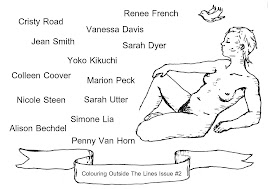



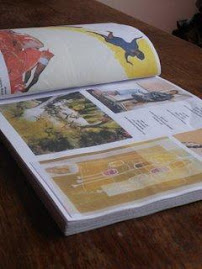



No comments:
Post a Comment